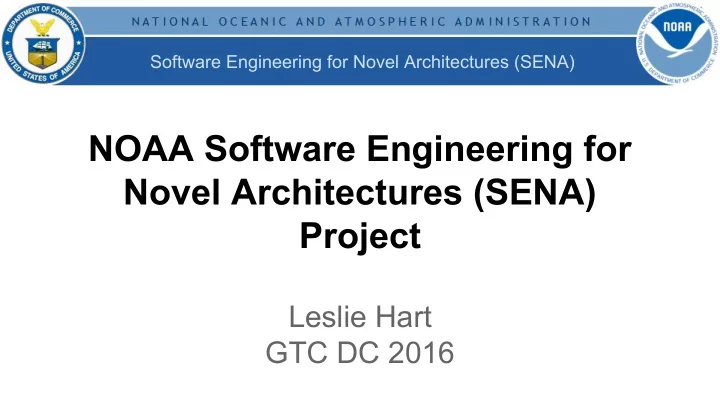

Software Engineering for Novel Architectures (SENA) NOAA Software Engineering for Novel Architectures (SENA) Project Leslie Hart GTC DC 2016
Software Engineering for Novel Architectures (SENA) Funding Language “NOAA will acquire software engineering support and associated tools to re-architect NOAA’s applications to run efficiently on next generation fine-grain HPC architectures.”
Software Engineering for Novel Architectures (SENA) What is “fine-grain” From a recent procurement document: “Fine-grain architecture (FGA) is defined as: a processing unit that supports more than 60 concurrent threads in hardware (e.g. GPU or a large core-count device).” (of course “traditional” architectures are getting to this point as well)
Software Engineering for Novel Architectures (SENA) Overarching Goals ● Prepare codes for a future production architecture ○ Monitor architectural evolution ● Maintain codes in a way that subject matter experts can still modify the code ● Monitor (and participate as appropriate) evolving standards ● Codes should still be viable for current (traditional) architectures ○ It is expected that code optimizations will increase performance on traditional architectures ● Develop expertise within NOAA
Software Engineering for Novel Architectures (SENA) Leadership Team - NOAA-wide Leslie Hart - OCIO V Balaji & Rusty Benson- GFDL Mark Govett - ESRL/GSD Leslie Hart (temp) - NCEP
Software Engineering for Novel Architectures (SENA) Priorities Models: WRF (ARW/NMM), FV3, GFDL Climate, NMMB Programming Research: Algorithm development, Programming approach Standards: OpenACC, OpenMP, LLVM
Software Engineering for Novel Architectures (SENA) Challenges ● Lack of standards across divergent architectures ● Large quantity of legacy codes ● Access to developmental platforms ● Uncertainty of performance gains
Software Engineering for Novel Architectures (SENA) Technical Issues Language (is Fortran/MPI still the right choice) Multiple layers of parallelism Task, Thread, Vector Optimal data ordering different across architectures Memory footprint of current fine-grain devices Atmospheric codes tend to have little data reuse
Software Engineering for Novel Architectures (SENA) Implementation Develop/cultivate relationships with vendors such as Intel, NVIDIA, etc Work with internal tools such as source-to-source translators to implement single source as much as possible Work with compiler vendors to ensure directive based approaches are feasible Develop small test environment coupled with access to larger government funded machines (DOE, NSF, NASA) Hardware, Compilers, Tools
Software Engineering for Novel Architectures (SENA) Status Funding distributed to GFDL, ESRL/GSD, NCEP Acquired/Acquiring test systems Beginning/continuing work on models Evaluating OpenACC and OpenMP versus source-to-source translation We really don’t want to be in the compiler business
Software Engineering for Novel Architectures (SENA) Fine-grain augmentation to Theia Hurricane Sandy supplemental funding provided for a traditional system (Theia - Haswell/Infiniband) and a Fine-Grain augmentation Waited for newer architectures Awarded to Cray with NVIDIA Pascal
Software Engineering for Novel Architectures (SENA) Fine-grain Augmentation Cray Storm system Dual Haswell (QDR Infiniband) 8 Pascals per node PCIE (not NVLink) Intel MPI and MVAPICH
Software Engineering for Novel Architectures (SENA) Fine-grain Comparative Benchmark Results TBD
Software Engineering for Novel Architectures (SENA) Experimental System (current status) Two NVIDIA K80 Nodes (1 per node) One AMD 9170 Node (1 per node) Two Intel Knights Landing nodes (one 68 core, one 64 core) Two “front-ends”
Software Engineering for Novel Architectures (SENA) Coming soon AMD 9150 node (in Fairmont awaiting network resources) Additional KNL (in Fairmont awaiting network resources) ARMv8 with NEON (Cavium 48 core, 2.5GHz, dual-socket) x4 Four additional KNL NAG Fortran Compiler PathScale compilers (including support for ARM)
Software Engineering for Novel Architectures (SENA) Synergy NOAA’s Next Generation Global Prediction System (NGGPS) Program NSCI NOAA is a “Deployment” agency Develop mission-based HPC requirements to influence the early stages of the design of new HPC systems and will seek viewpoints from the private sector and academia on target HPC requirements (of course this is a software and hardware problem)
Software Engineering for Novel Architectures (SENA) Conclusion The SENA project is just starting, it is an attempt to consolidate and accelerate existing NOAA projects The efforts and results will be useful even in the event that fine-grain architectures do not become as price/performance competitive as some have anticipated Thank You!
Recommend
More recommend